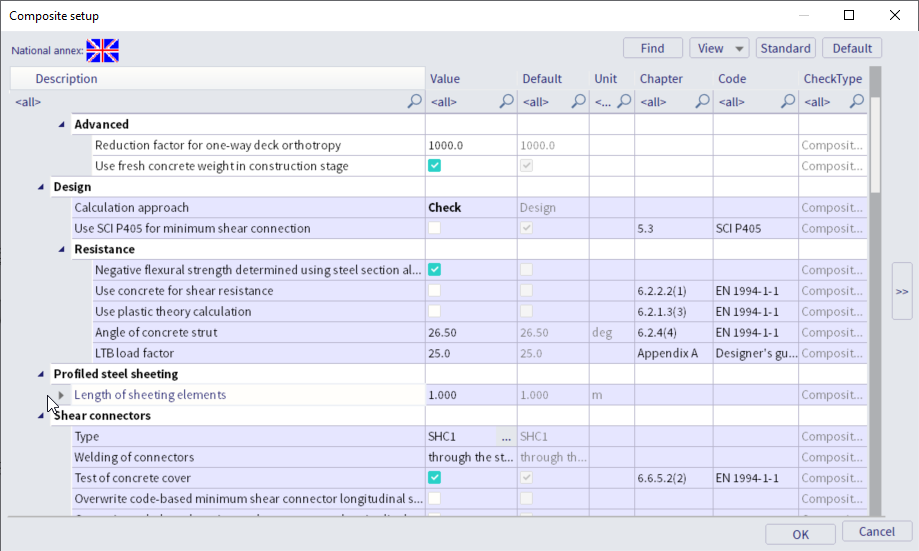Composite setup
The composite setup can be accessed from the composite service tree. It contains a number of settings that are related to the CAM and to the composite checks. Only CAM related settings are detailed here. These settings affect the analysis model. Check related settings are presented later, along with composite checks ("Composite Checks").

| Take creep into account | defines whether creep should be taken into account or not in the CAM; when this setting is disabled, final stage, long term is not used and any load case assigned to that stage are moved to final stage, short term. When enabled, all load cases in the composite final stage, long term are calculated using a reduced value of the concrete E-modulus for composite decks, based on the nominal value and the creep coefficient. |
| Creep coefficient | value of the creep coefficient for the calculation of the effect of creep in final stage, long term. |
| The composite beams are propped | defines whether the composite beams should be considered propped or not during casting; when this setting is enabled, construction stage is not used and any load case assigned to that stage is moved to final stage, long term or final stage, short term depending on the creep setting. |
|
Degree of connection for beams with standard composite action
|
defines the degree of connection of composite beams with standard composite action. An equivalent moment of inertia is calculated, based on the desired degree of composite action, the inertia of the steel beam alone and the transformed inertia of the composite cross-section assuming total connection. That approach is based on AISC 360-10 eq (C-I3-4). In the case of the Design calculation approach, the value is read-only and automatically defined, depending on the selected design approach. In the case of the Check calculation approach, in order to accurately calculate deflections, the value entered should closely match the degree of connection resulting from the number of studs entered. For IBC projects only: If the value entered does not match the degree of connection calculated from the number of studs, the members in model can be updated with the calculated degree of connection by selecting apply design proposals to model. |
| Length of sheeting elements | default value for the length of sheeting construction elements; this setting is taken into account in the LTB steel code check for the stabilizing influence of the profiled steel sheeting on the steel beams |
| Reduction factor for one-way deck orthotropy | reduction factor for the stiffness components in the weak direction; the relevant components of the nominal orthotropy matrix will be divided by that coefficient; for details "Composite Analysis Model - Theoretical background" |
| Use fresh concrete weight in construction stage |
enabling this option causes the self weight of composite deck to be calculated separately for steel and concrete; any inputted self weight load case is split into 3 partial self weight load cases:
|
In practice, all self weight load cases are always assigned to the construction stage, because the weight of concrete is carried by the structure before composite action can take place
The automatic generation of composite combinations has been extended to all types of structure. The corresponding setting has been moved from the Composite setup to the Project data dialogue (Actions tab). For more information, see .Automatic code combinations.

